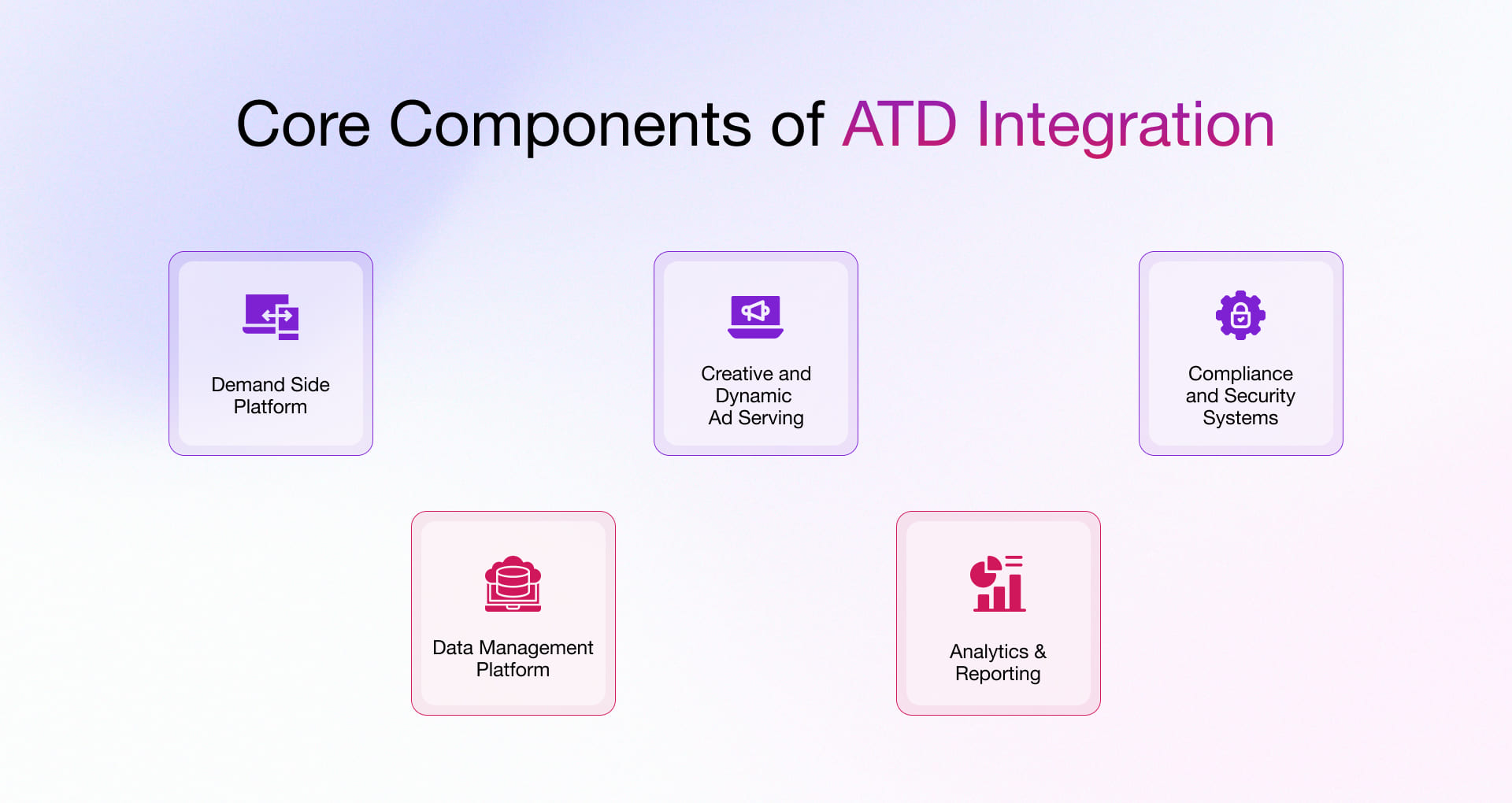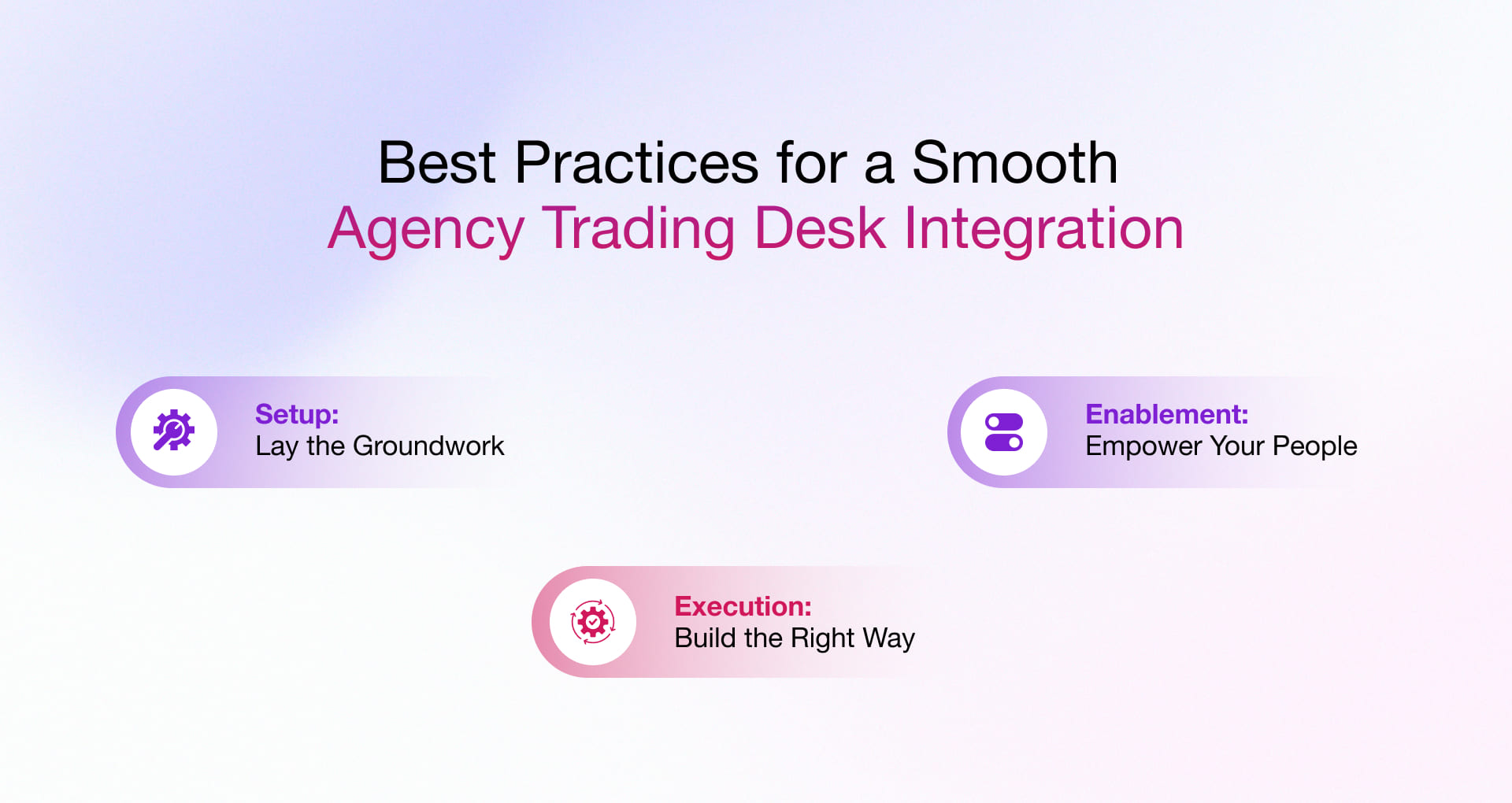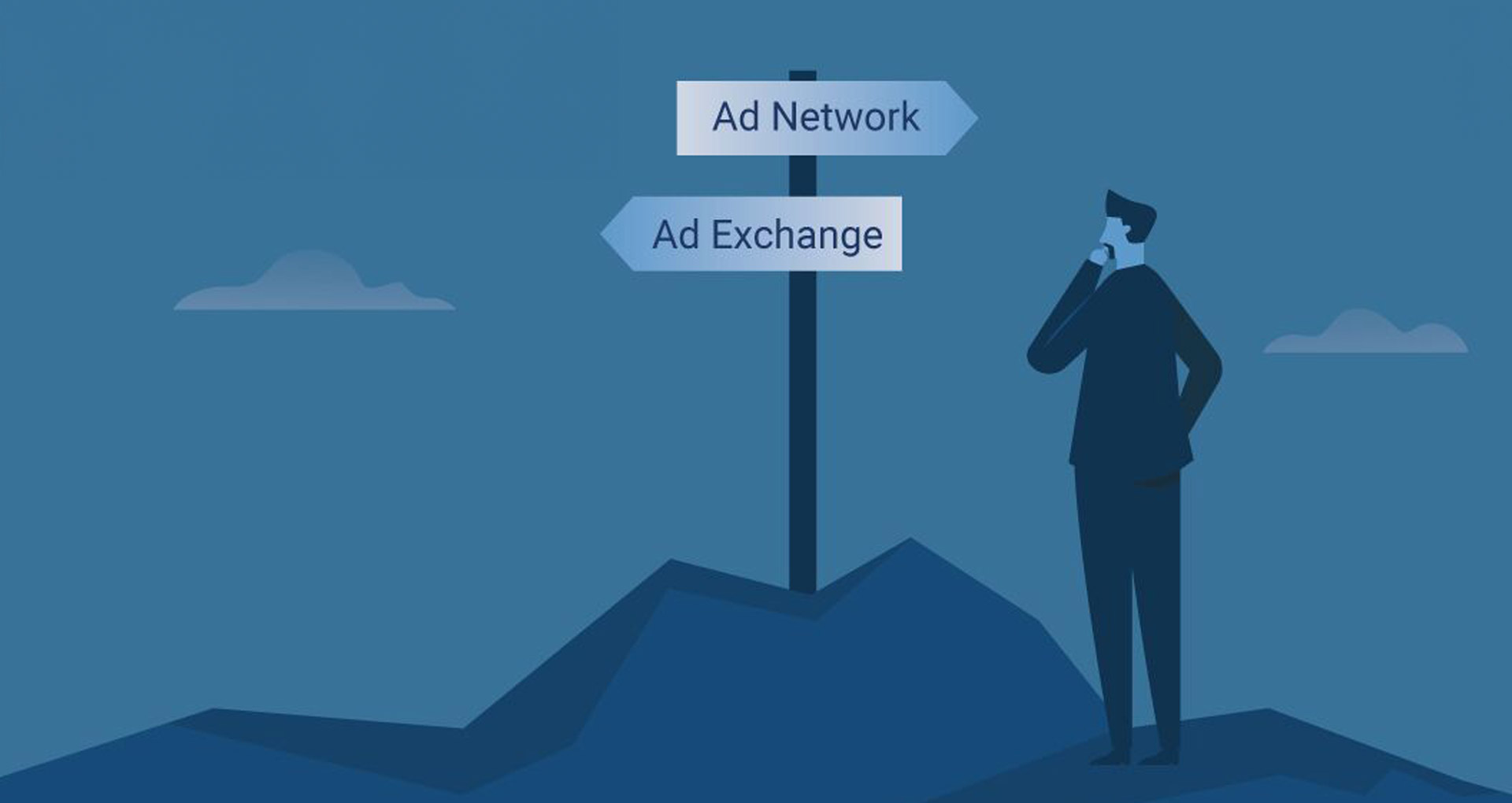Managing programmatic advertising today is anything but simple.
Disconnected platforms, fragmented workflows, rising customer expectations, and evolving compliance demands have made ad operations more complex than ever.
For agencies looking to streamline their processes, improve targeting, and gain tighter control over media buying, Agency Trading Desk (ATD) integration is no longer optional, it’s essential.
By building a connected, data-driven ecosystem, ATD integration helps unify workflows, optimize ad placements, and drive measurable performance improvements across channels.
In this guide, we’ll walk you through:
Key Considerations for Agency Trading Desk Integration
When planning agency trading desk integration, both business strategy and technical readiness must align. Below are the key decision points agencies need to evaluate before moving forward.
Business Considerations:
- In-house vs. Outsource Expertise: Running an ATD requires more than just technical setup. It demands operational skillsets like media buying, data analytics, and compliance management. If your internal team lacks deep experience, outsourcing to a managed service provider may save time and minimize errors.
- Cost and ROI Expectations: Are you prepared for the upfront investment, and do you have a clear ROI model? An agency trading desk requires an upfront investment in platform, data architecture, and talent. Assess whether the expected performance gains, cost efficiencies, and campaign scale justify the financial commitment.
- Scalability of Operations: Think ahead. Can your team and tech stack handle more clients, more campaigns, and more complexity as your business grows? Starting with a scalable foundation now avoids growing pains later.
- Available Internal Bandwidth: Beyond setup, agency trading desks need ongoing management: optimizing campaigns, adjusting strategies, handling reports. Be honest about whether your current team can take this on, or if they’re already at capacity. If your team is already stretched thin, resource planning becomes critical.
Technical Considerations:
- Data Architecture and Compliance: A strong data setup is vital to integrate ATDs well and remove future hurdles. Integration between DSPs, DMPs, SSPs, and ad servers must be seamless, secure, and privacy-compliant. Following data privacy rules is crucial. Make sure your integration respects user privacy and follows industry norms.
- Platform Compatibility: The success of ATD integration hinges on how well your existing systems communicate with each other. So, evaluate if your Demand-Side Platforms, Supply-Side Platforms, DMPs, and analytics tools can connect natively or via APIs without heavy custom development? Are there potential bottlenecks or incompatibilities that could delay go-live or hinder performance?
- Collaborating With Experienced Technology Partners: Teaming up with seasoned AdTech services provider partners such as Rishabh Software, can dramatically reduce complexity, risk, and implementation timeline. These partners bring expertise in tailoring your agency trading desk setup handling API links and fixing any problems that pop up during the ATD integration.
- Platform Interoperability: A strong trading desk doesn’t work in isolation. It should connect easily with your existing tools—CRMs, CDPs, analytics platforms—so you get a full picture of performance and user behavior without manual workarounds.
- Real-Time Bidding Infrastructure: Your setup needs to be fast, stable, and reliable. The ability to bid in real time—at scale—directly impacts how competitive and efficient your campaigns are.
- Automation Readiness: From setting rules to optimizing spend, and adjusting in real-time, automation is key to scaling without overloading your team. Look for tools and platforms that support smart, rules-based or AI-driven automation out of the box.
- Privacy and Security Compliance: With data regulations tightening, ensure your entire stack from user data capture to reporting follows GDPR, CCPA, and other standards. Strong security isn’t optional, it’s essential for client trust.
Core Components of ATD Integration
Integrating an Agency Trading Desk (ATD) into your AdTech ecosystem requires more than connecting isolated platforms.
A seamless, high-performing ATD environment depends on five key components working in harmony:

- Demand Side Platform (DSP): The Demand-Side Platform (DSP) is where the actual programmatic media buying happens. It allows agencies to access multiple ad exchanges and bid for ad inventory in real time. Seamlessly integrating the DSP with the agency trading desk enables automated bidding, smart budget adjustments, and dynamic campaign optimizations based on live data. Through real-time bidding (RTB) capabilities, the DSP evaluates and bids on thousands of ad impressions within milliseconds, helping agencies capture high-value opportunities efficiently. Without a strong DSP connection, bidding delays and data loss can severely impact campaign performance.
- Data Management Platform: A Data Management Platform (DMP) is like the heart of the ATD system. It collects, organizes, and manages audience data from different places. When the DMP is connected well with the agency trading desk, it helps in targeting the right audience with better accuracy. This integration also makes it easier to use real-time audience data for improving bidding strategies and campaign performance. Without a good DMP setup, ad targeting can become messy and less effective.
- Creative and Dynamic Ad Serving: Dynamic ad serving ensures that the right ad is shown to the right person at the right time. Instead of using the same static ads for everyone, dynamic serving adjusts the creative based on user behavior and context. When creative tools are connected well with the ATD, it helps deliver personalized ads easily, test different ad versions, and improve engagement without much manual effort.
- Analytics & Reporting: Analytics and reporting tools help track how campaigns are performing across different channels. Integrating these systems with the ATD gives a clear view of what’s working and what needs fixing. It also allows agencies to make quicker changes based on real data instead of guesswork. Without strong analytics, it becomes hard to prove ROI or improve campaign strategies.
- Compliance and Security Systems: With stricter data privacy laws like GDPR and CCPA, compliance and security systems have become a must for any agency trading desk setup. These systems make sure that user data is collected, stored, and used safely and legally. Integrating compliance frameworks into the ATD helps agencies avoid legal risks, protect customer trust, and scale operations confidently.
How to Choose the Right ATD Integration Model
Selecting the right agency trading desk integration approach depends on several factors, including your campaign scale, geographic reach, and long-term business goals.
For most agencies, a single platform integration—connecting a DMP, DSP, dynamic ad serving, analytics, and compliance systems—is ideal for streamlining day-to-day operations and improving media buying efficiency.
However, for larger agencies managing campaigns across multiple regions or verticals, connecting multiple ATDs together can offer better centralized oversight, enhanced transparency, and unified performance management across teams and geographies.
Carefully evaluating your operational needs and growth plans will help determine whether a single-platform ATD or a multi-ATD environment is the right fit for your business.
Best Practices for a Smooth Agency Trading Desk Integration
A successful Agency Trading Desk (ATD) integration requires more than just connecting platforms. It needs careful planning, technical execution, and operational readiness.
Here are some best practices that will help you manage the integration smoothly and set up their ATD for long-term success.

1. Setup: Lay the Groundwork
Before starting the integration, it’s important to:
- Audit your existing AdTech stack: Identify all touchpoints—DSPs, SSPs, DMPs, analytics platforms—and evaluate their compatibility with your agency trading desk. Look for redundancies and areas where integration may require custom development.
- Clean and normalize your data: Data consistency is critical for real-time bidding and unified campaign reporting. Invest in standardizing taxonomy, segment definitions, and attribution rules before integration.
- Verify platform compatibility: Ensure your ATD can interface with your core tools through APIs, data connectors, or middleware solutions. A compatibility checklist will save time during execution.
2. Execution: Build the Right Way
- Run pilot tests in a sandbox environment: Use controlled testing to validate integration logic, data flows, and campaign performance before going live.
- Choose the right technology partners: Look for vendors with:
- Proven experience in AdTech integrations
- Scalable solutions that grow with your business
- Strong support teams and SLAs for ongoing maintenance
- Align on integration milestones: Map out a timeline for API connections, workflow orchestration, and QA testing. This ensures your tech and media teams stay in sync.
3. Enablement: Empower Your People
- Train teams across roles: Educate media buyers, data analysts, and account managers on how to set up campaigns inside the agency trading desk, interpret new dashboards, and troubleshoot common issues.
- Align stakeholders on goals: Hold onboarding sessions with both technical and business teams to ensure alignment on KPIs, campaign metrics, and operational workflows.
- Document processes and workflows: Create internal playbooks to reduce reliance on external support. Include integration guidelines, troubleshooting steps, and update protocols.
How Rishabh Software Can Support Your Agency Trading Desk Integration Journey
Integrating an Agency Trading Desk (ATD) into your AdTech ecosystem isn’t just about connectivity. It’s about creating a unified, data-driven environment that drives performance and transparency.
At Rishabh Software, we help agencies and businesses simplify the complexity of ATD integration through a proven, scalable approach.
Our expertise covers every key aspect of the process, including:
- Custom API development to ensure seamless platform interoperability
- Secure data flow implementation across DSPs, DMPs, ad servers, and analytics systems
- Real-time analytics integration for faster optimization and reporting
- Compliance-first design to meet global data privacy and security standards
With deep experience in building tailored AdTech solutions, Rishabh Software ensures that your ATD environment is robust, scalable, and future-ready—helping you drive stronger media outcomes with less operational overhead.
Frequently Asked Questions
Q: What is Agency Trading Desk (ATD)?
A: A simple agency trading desk definition would be: a dedicated service layer within an agency that handles media buying through real-time bidding (RTB) and data-driven strategies.
Some well-known agency trading desk examples include Xaxis (by WPP) and Accuen (by Omnicom Media Group), both of which manage high-volume programmatic operations for large brands globally.
Q: How Agency Trading Desk Works?
A: Agency Trading Desk streamline the buying and selling of digital ad inventory through automated real-time bidding (RTB) and data-driven strategies:
- Ad Inventory Management: ATDs connect with DSPs and SSPs, providing agencies with access to a diverse range of ad inventory from multiple publishers and exchanges.
- Real-Time Bidding (RTB): Agency trading desk use RTB to buy ad space in real time, optimizing media buying efficiency through targeted bidding based on audience data.
- Data & Analytics: ATDs leverage data insights from various sources, like DMPs, to enhance ad targeting and ensure ads reach the most relevant audience.
- Campaign Optimization: ATDs continuously monitor and adjust campaigns in real-time to improve performance and maximize ROI.
Q: What are the Technical Challenges of ATD Integration?
A: Some technical challenges of ATD integration include compatibility across different platforms (DSPs, SSPs, ad exchanges), managing complex data flows, handling real-time bidding latency, and maintaining seamless communication between various systems.
Q: How Does Agency Trading Desk Integration Improve Campaign Performance?
A: Agency Trading Desk integration improves your overall campaign game by enabling more efficient media buying, providing real-time information on ongoing campaigns, and empowering you to be more focused on data-driven decisions.
Q: How Long Does Agency Trading Desk Integration Usually Take?
A: Agency trading desk integration typically takes 4 to 8 weeks, whereas this time duration can vary based on the complexity of your ad tech stack and customization needs. Partnering with experienced providers can streamline the process.











 30 Min
30 Min


